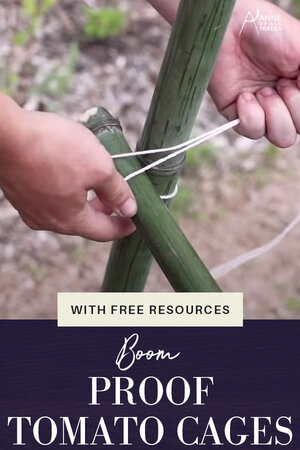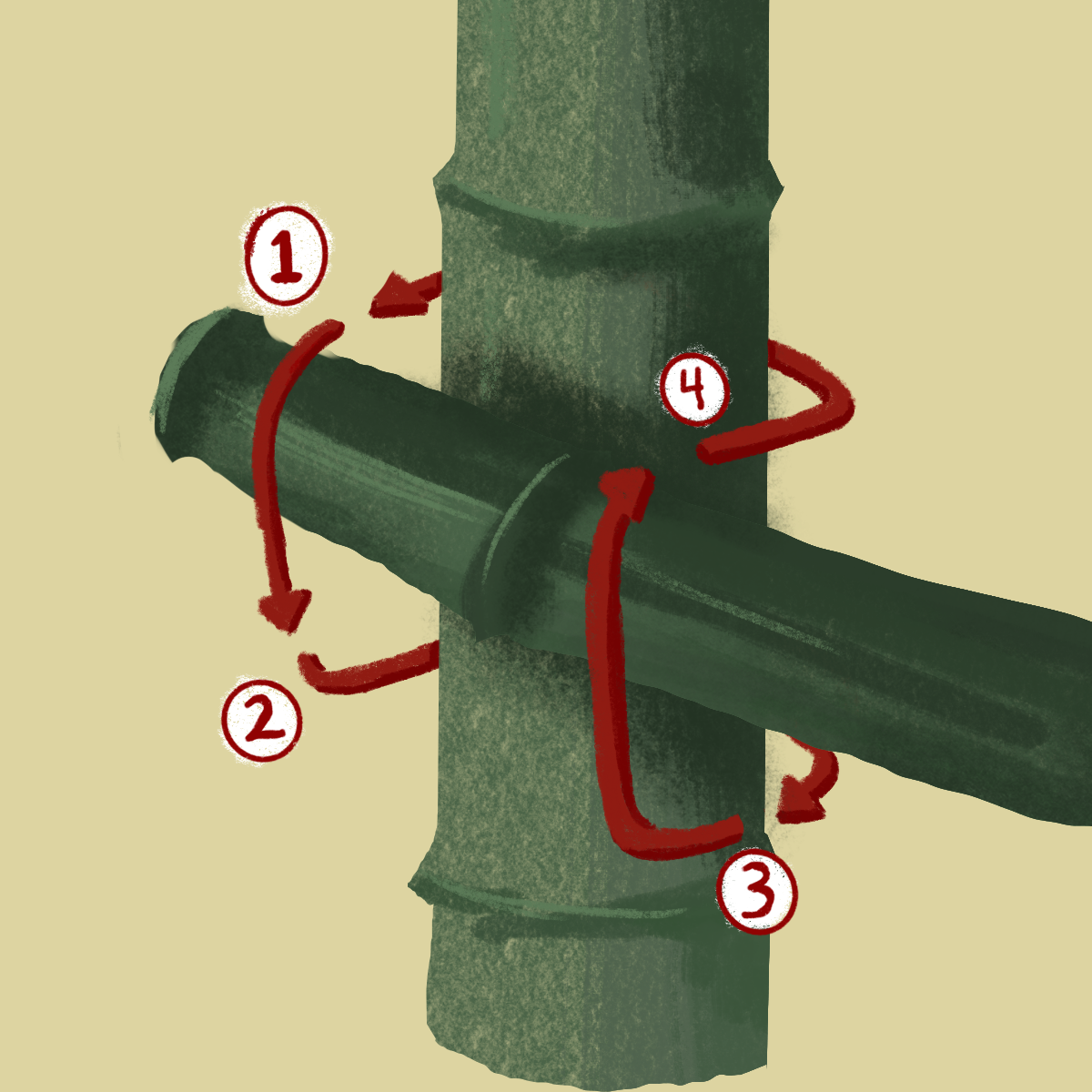DIY Tomato Cages Using Japanese Style Lashing
Learn to make easy and affordable DIY tomato cages, tomato trellises, and all kinds of garden structures using bamboo, and this Japanese lashing technique.
Why I Love These Tomato Cages
When growing tomatoes, the tomato varieties will dictate if you need a tomato trellis, stake a cage, or use a tomato tower. In the new garden in Tennessee, we planted indeterminate tomatoes and they grew fast, needing support. This presented a problem. I could either go buy A LOT of tomato cages that would need storing over the winter or I could make something myself.
Because I started the garden in the middle of a pandemic, the options to even buy store bought tomato cages, making my own out of cattle panels, other livestock panels, welded wire fencing, etc. were limited. I needed to get resourceful using what I had nearby to build a simple tomato support that was far stronger than the wire cages that are notorious for falling over, and didn’t require unique materials or tools like concrete reinforcing, or bolt or wire cutters for assembly.
That's when my friend Josh Nava told me about an insanely easy and cheap way to make all kinds of garden structures using an easy Japanese lashing technique. So I opted to embrace my inner Swiss Family Robinson, and build some cages out of bamboo. Lucky for me, my neighbor has quite the patch growing. So we loaded up the trusty golf cart with a healthy supply of green canes, and got to work! And, of course, I had a ton of fun driving down the road with 30 feet of bamboo tied to the roof of my golf cart!
Materials Needed
Live Bamboo - If you are not fortunate enough to have a patch of bamboo growing close by, get creative and use whatever lumber, poles, or PVC pipe you do have available. The amount needed depends on the size of your project. For reference, I harvested 15-20 bamboo shoots roughly thirty feet tall and one inch in diameter.
Sawzall - Do not use a pruning blade, as it will damage the bamboo. A metal cutting blade works best for harvesting bamboo.
Hatchet - A knife can alternately be used, but I found that a hatchet was more efficient and more comfortable in my hands.
Cotton String - This adds to the beauty of your garden structure, but if that doesn’t matter to you, you are short on time, or have zip ties handy instead, the lashing step can alternatively be accomplished with zip ties.
Clamps - These are needed because you will run out of hands. If you are not doing this project alone, “helping hands” can assist you in holding the bamboo in place.
Rebar - Used to hollow out pieces of bamboo to make longer cages. If you are making square cages, the rebar is not needed.
Step by Step Instructions
Harvest bamboo with Sawzall cutting as close to the ground as possible. As it dries, bamboo hardens, so leaving as little of a stump as possible will leave the area without stumps to trip over in the future.
Working with the grain of the bamboo (from the bottom towards the top), remove branches with a hatchet.
With a swift angled chop, cut off the tops of the bamboo.
With the Sawzall, cut the bamboo into desired lengths. I have narrow garden walkways, so I kept my horizontal pieces no more than three feet across, and my vertical pieces were five feet tall. These measurements should be adjusted to fit your unique gardening space.
Drive the long vertical bamboo pieces by hand into the ground by twisting them until they are deep enough to securely stay in place. Smaller cages can use four vertical pieces to make a three-foot square, or for larger cages, continue the length of your tomato garden by adding additional vertical pieces spaced about three feet apart.
Clamp a horizontal piece of bamboo at the desired height (the height the tomato is currently growing). Make sure to leave about two inches of bamboo on the outside edges, so that the perpendicular horizontal bamboo pieces will have a place to set. Use the following Japanese lashing technique:
Cut a length of string about as long as you are tall.
Starting from behind, bring your string underneath the cross piece you will be tying.
Even up both ends of the string.
Pull both sides up and wrap the strings around the back of the vertical post. This will pull the horizontal post tight against the other.
Continue to wrap both strings around the posts very tightly twice in the illustrated order.
Split the strings, and bring one in front and the other behind.
Bring the front string across and down forming an “X” with the strings on the front.
Bring the bottom string across the top and behind, and gather both strings at the back.
Cinch the wraps tight using a “frapping” turn. Wrap the strings around the middle, in between the posts, and around the strings.
Pull tight, and repeat three times finishing off with a double knot.
7. Repeat step 6 adding as many horizontal pieces as needed down the length of your row of tomatoes.
8. Before repeating step 6 to add horizontal pieces that are now running perpendicular to the existing horizontal pieces, hollow out the bamboo using a piece of rebar. The rough edges of the rebar will act as a file to hollow it out. Insert the narrow end of the bamboo into the larger ends, and repeat to the desired length. This will add strength and structure to the bamboo as opposed to leaving it in one long piece at the harvest stage. Repeat step 6 to attach the perpendicular pieces.
9. Step 8 can be repeated down the center of the tomato cage if needed.
10. Stake tomatoes, and repeat steps 6-9 as the tomato plants grow and need more support.














